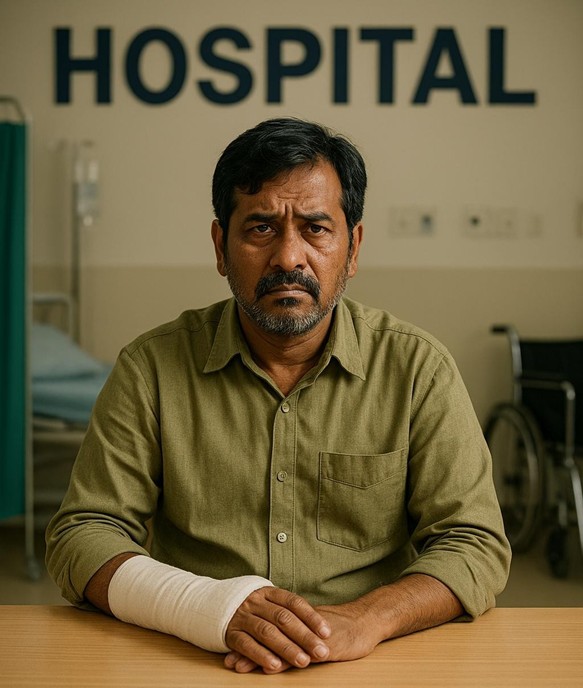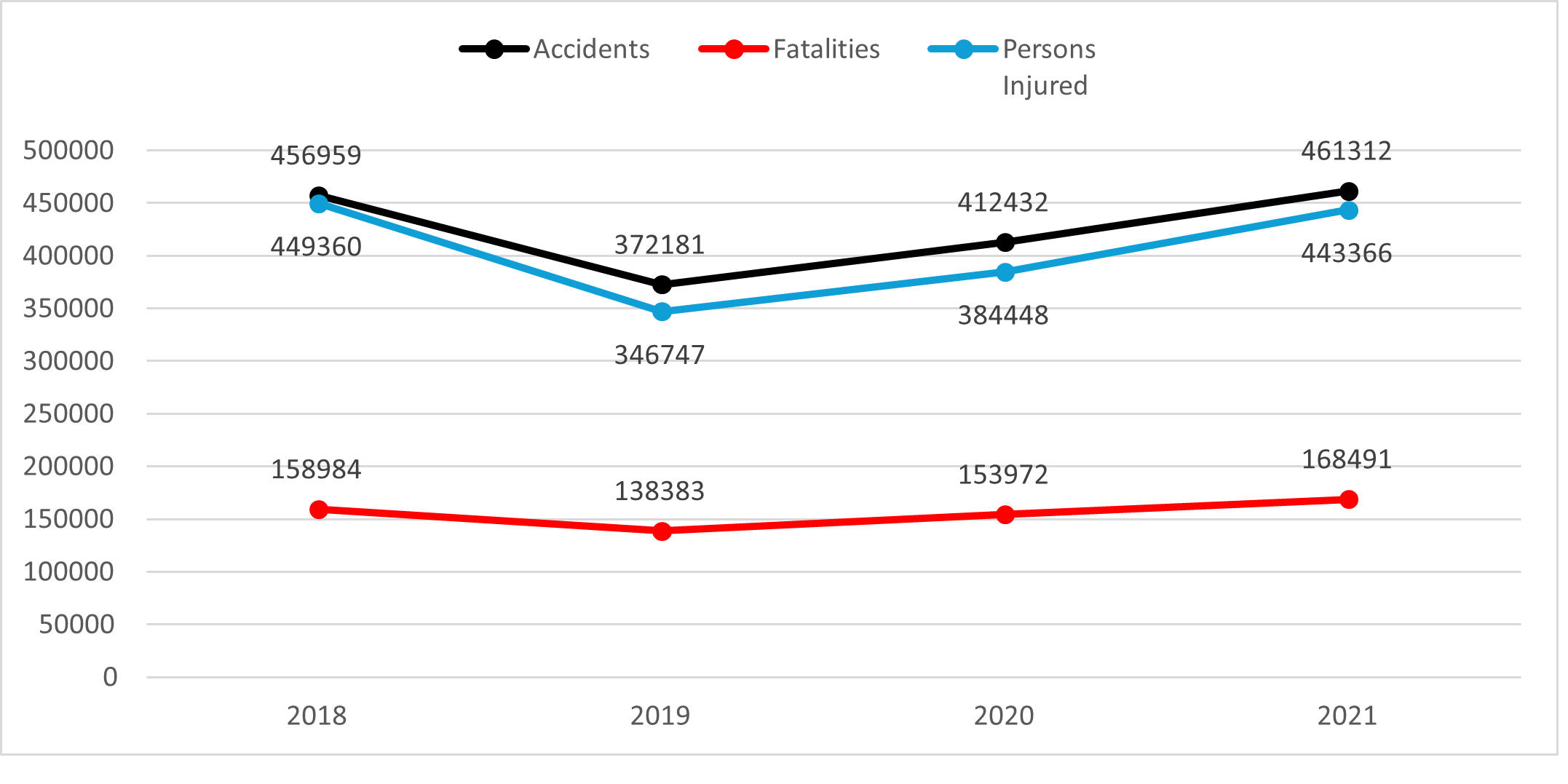
The Short Story of Ramesh:
Ramesh, a father of two, works as a delivery driver in a bustling city. Every day, he wakes up early, gets on his two-wheeler, and rushes to fulfill orders to support his family. For him, life has always been about working hard to make ends meet. He earns just enough to provide the basics: food, rent, and school fees for his children.
One evening, while rushing to deliver an order, Ramesh was involved in a road accident. He suffered severe injuries to his leg and needed immediate medical attention. After being rushed to the hospital, Ramesh was informed that he would need surgery followed by months of rehabilitation.
Without any savings to fall back on, Ramesh was suddenly faced with overwhelming hospital bills. His recovery kept him away from work for several months. His family, dependent on his earnings, found themselves struggling to pay for daily expenses, let alone cover the medical costs. With no financial safety net, the pressure mounted. His children’s education was at risk, and their future looked uncertain.
Ramesh’s story is not unique. Every day, thousands of families like his face a similar situation where an accident pushes them into a financial crisis. But this doesn’t have to be the case.
Why Personal Accident Insurance is a Necessity for Low-Income Families
In India, an accident happens every 53 seconds, and 1,264 accidents and 462 deaths occur daily. Many low-income families, like Ramesh’s, are especially vulnerable because they depend on high-risk, informal jobs such as driving, construction, or factory work — often with no social security or insurance coverage.
In 2022 alone, the Ministry of Road Transport and Highways reported:
- 4,61,312 road accidents
- 1,68,491 fatalities
- 4,43,366 injuries
For those in low-income brackets, 80% of accidental deaths happen through the very modes of transport they can afford: walking or using two-wheelers.
With these statistics in mind, personal accident insurance is not just an optional extra - it is a necessity. It ensures that low-income families don’t lose their savings, livelihood, or future due to an unexpected event.
Figure 1: Trends in number of Accidents, Fatalities and Persons Injured: 2018 to 2022

Data Source: Ministry of Road Transport and Highways, Government of India
In addition to the current alarming scenarios of accidental deaths, the low-income households are affected financially in the form of:
1.The Risks That Low-Income Families Face 1. Loss of Income and Work
For low-income families, the loss of the primary breadwinner can have devastating effects. Jobs in the informal sector — like Ramesh’s delivery work — often offer no benefits or insurance coverage. An accident can mean not just physical pain but also the inability to work, leading to:
- No income to support the family
- Loss of daily wages
- Financial instability
With limited or no savings, the family can quickly fall into financial ruin.
2. The Burden of Medical Costs .
Accidents often come with hefty medical bills that low-income families cannot afford. Beyond the lost income, Ramesh’s family had to worry about:
- Hospitalisation expenses
- Recovery costs (medications, surgeries, follow-ups)
In cases like Ramesh’s, these costs can push families deeper into debt or force them to sell valuable assets just to survive.
3.Long-Term Impact on the Family’s Future
The ripple effect of an accident is often felt for generations. When low-income families struggle financially:
- Children may drop out of school because they can’t afford fees
- Family members may be forced into informal or unsafe jobs to make ends meet
- The entire family may spiral into poverty
Personal accident insurance is crucial not just for immediate protection, but for safeguarding future opportunities for children and generations to come.
How Microinsurance Can Help: A One-Stop Solution for Low-Income Families
Microinsurance for personal accidents is specifically designed for families like Ramesh’s, offering affordable protection in times of need. Although, programs like Pradhan Mantri Suraksha Bima Yojana (PMSBY) (₹2 lakh cover for accidental death or total disability, 1 lakh for partial disability, all for just ₹20/year) are revolutionizing access to insurance for low-income households, we need more insurance players serving the underserved and unserved population of India.
What Does Personal Accident Insurance Cover?
Personal accident microinsurance typically covers:
- Accidental death
- Partial Total disability
- Permanent total disability
In addition, the policies can also be customised by the policyholder as per the requirement such as loss of income, hospitalisation expenses, grant for continuing education of children etc.
By selecting the right plan, families can tailor coverage to suit their needs and ensure they don’t fall through the cracks during times of crisis.
Conclusion: Don’t Wait Until It’s Too Late
Ramesh’s story could have had a different ending had he invested in personal accident insurance. With the right coverage, families can protect themselves from the financial devastation caused by an accident.
Personal accident insurance is not just a precaution; it’s a lifeline. It provides the peace of mind that families need to recover and rebuild after an accident, without losing their hard-earned savings or putting their future at risk.
For those in low-income households, it’s time to take that first step toward protection — before an accident strikes. A small investment today can safeguard your family’s tomorrow.
References:
About Micro Insurance Innovation Hub Foundation
The Micro Insurance Innovation Hub Foundation is dedicated to expanding access to microinsurance across India and the Asia Pacific region. Based in Hyderabad, the Hub works to create inclusive insurance products that cater to underserved communities. Its mission is to protect vulnerable families and promote financial inclusion through innovative insurance solutions.
Disclaimer
The Micro Insurance Innovation Hub (MIIH) Foundation is a Section 8 company committed to promoting financial inclusion through microinsurance. The information in this article is for awareness and discussion purposes only. Sources include:
- Pradhan Mantri Suraksha Bima Yojana (PMSBY)
- Ministry of Road Transport and Highways